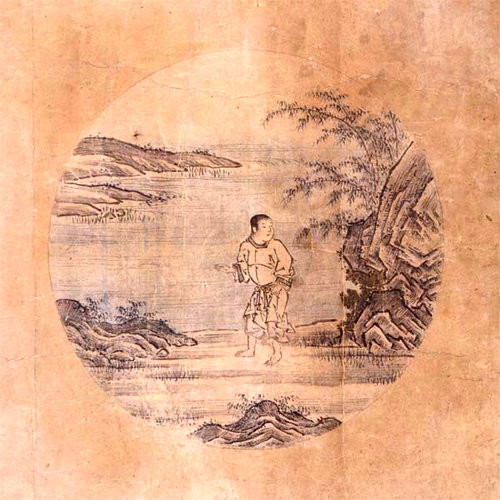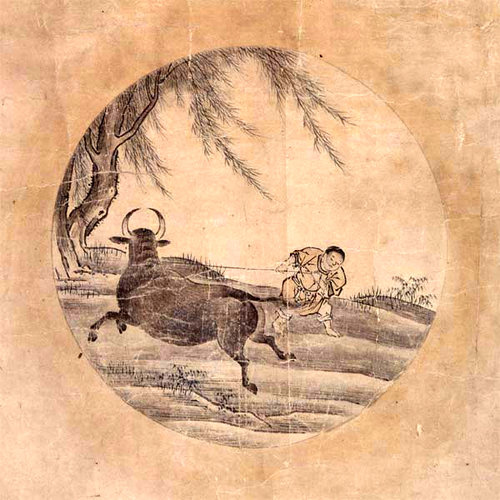Practicing Zen
What image comes to mind when you hear the word Zen?
If you picture something calm and tranquil, I hope this article will surprise you. While it happens occasionally, my experience of Zen is generally neither calm nor tranquil. In fact, Zen has an uncanny way of making me feel more worked up. So why do I practice it?
Gentling the bull
Zen practice is like a loving, yet strict parent. This parent knows that while a child may hate broccoli, it’s good for them and they’ll probably grow to enjoy it. The parent encourages the child to eat it.
But what happens when you make a small child eat something as obviously abhorrent as broccoli? What if the child wants chocolate and you say no? You’ll learn that the child has a powerful energy inside them like a wild animal.
As we grow up we learn that some expressions of this energy – our emotions – are socially acceptable, while others are not. Some are good and some are bad. Other people don’t like it when we have tantrums, so we learn to suppress the energy that drives them. Over time we separate ourselves from emotion, which becomes something that happens to us rather than something that is us.
Zen suggests that suppressing this emotional energy isn’t the way to go. Instead, we should see our emotions like a wild bull that, while powerful, is neither good nor bad. Rather than remain ignorant of the bull, we look for it and aim to tame it.

There’s a wonderful series of ten paintings and poems that shows the steps of the herdsman (‘us’) gentling the bull. This is the Zen journey towards enlightenment.
The first four show the journey from almost total ignorance to when we truly face this emotional energy. Going back to the broccoli: how might a child respond when you make her eat broccoli, something she really doesn’t want to do?
At first, she has no awareness of herself as being separate from her anger. She’s being a little ball of fury. The bull is nowhere to be seen, hiding in plain sight.
With a little more awareness she notices broccoli on the floor and tears in her eyes: evidence of the bull.
With more awareness she sees herself throwing broccoli at her parents as her anger subsides. Have you ever caught yourself yelling at a loved one, knowing that you’re being unreasonable, but still unable to stop? A glimpse of the bull, though it got away this time.
One day, when confronted with broccoli, she sees how her entire body twists and contorts inside. She feels hot and her heart races. She struggles with this energy, longing to let it overwhelm her and to push the broccoli away again. But this time is different: she stays with the energy, experiencing it fully without reacting. It reaches a peak, shifts and subsides.
This is what it’s like to catch the bull.

We emerge from such a bull encounter a different person. When we engage with that raw emotional energy we let its power transform us. And since the energy is what we truly are, before we separated ‘it’ from ‘us’, we are transformed by it in a way that takes us closer to our true nature.
If all this sounds uncomfortable, that’s because it is. To practice Zen is to fully experience your emotions without pushing them away or being swept away by them. The trick is to stay still even when stormy inside. Especially then. That’s where the Daily Life Practice comes in.
The Daily Life Practice
In sitting meditation you hold a particular posture and must not move, no matter what comes up inside. You have to eat your broccoli with a smile.
The Daily Life Practice is similar, making you meditate for one hour every day, follow a daily schedule around sleep, meditation and meals, and give yourself wholeheartedly to everything you do.
A typical day might look like this.
The alarm goes off at 6.00 am. There’s an inner sense of urgh as you turn it off. I don’t want to get up. You’re on the meditation cushion at 6.20 am, but in a bad mood after the whole alarm thing. The prospect of sitting quietly for an hour counting your breaths doesn’t appeal. Maybe just 30 minutes?
You do the full hour then have to iron a shirt for work. This is boring, I’ll put on a podcast. Not so fast, chides the Daily Life Practice. You need to iron wholeheartedly, remember? This inner monologue continues as you pay close attention to your senses while you iron: the radiant heat, the easy slide of the iron, the smell of damp cotton, the sound of the high-pressure steam. Having grappled with the bull, you may feel calm. But stay vigilant! it’s not tame yet.
Like a child made to eat broccoli, we naturally resist this kind of rigid, imposed structure. The genius of the Daily Life Practice is that the structure that triggers emotions also forces us to stay with the energy of the emotions.
What’s on the other side?
I’ve only had glimpses of what’s available, but one experience stands out.
Walking to work one day – no music, no podcast – I gave myself fully to what was happening. The bull was craving entertainment, but I left it to rage as I denied it any distraction. As it settled down, it transformed into something quite different.
As I paid attention, I thought I could feel my body moving, hear the birds singing and see the trees swaying. But that was just it: thought. I realised I wasn’t experiencing them directly, instead I was listening to my thoughts describe them. And I couldn’t stop it. My thoughts were happening by themselves and seemed like external objects, no different from how I would experience seeing a car.
With that awareness came a cascade of knowing. I saw that my thoughts were made of the same stuff as the feeling of my body moving, the sound of the birds and the swaying of the trees. Everything inverted as my mind expanded outside my head and the world came rushing in. The idea of any difference between inside and outside made no sense and it was plainly obvious that any notion that ‘I’ exist separately of ‘all that’ was a ludicrous illusion.
While this experience was blissful, although a very ordinary kind of bliss, I quickly returned to my habitual way of being. While I love these moments when they happen, I don’t go after them. These things cannot be aimed at directly. The only way to go forward is to continue the same way I arrived: meditate for an hour every day, set and follow a daily schedule, and give myself wholeheartedly to everything I do.